BULLETIN OF THE FAR EASTERN BRANCH,
RUSSIAN ACADEMY OF SCIENCES
Scientific and public-political journal of Presidium FEB RAS
Founded in 1932
Publishing is discontinued in 1939, renewed in 1990
Dalnauka, 1(123). 2005
in RUSSIAN
The Bulletin FEB RAS. 2005.5
Not once on the pages of our journal the scientist-teachers with their vision of problem of formation. V.D.Lindenbraten,
doctor of medical sciences (1996, ¹ 3), writes: pulling to research new information s programmed in genetic device,
why under questioning 95 % senior schoolboys and 55 % students declare that they dislike to learn? The repulsion to
school is formed gradually. Consequently, it is brought up. Is it possible to return the lads initially programmed and
artificially oppressed longing to knowledge in them? One of the the most most important ways to this Lindenbraten considers
the actualization of education: knowledge can not be sent by means of tale or show, they can be received only
by way of active trained. The quality criterion of such education is not a volume of knowledge, but possession
by skills of independent work in conditions of uncertainties. The Doctor of physico-mathematical sciences V.F.Filaretov
(2000, ¹ 2; 2004, ¹ 5), voicing alert about that that the interest of graduates to technical science directions in recent
years, sees only one output: and at a rate of state, and at a rate of region, and at a rate of edge, city, institute,
school to stimulate receipts of talented youth in science and production. Here can be useful as special contests on
professions, as forgotten clubs of young technicians, also it can be trips of schoolboys on conferences, exhibitions
of young mathematicians, biologists, technicians at Academies, and etc. It is unnecessaryto have a lot of it. The main
idea is to have it and that this stimulate. Never mind, will these lads go in science: they will try to put and solve
the professional problems non-standard on any place.
In article published below we can see one of approve of phenomenon "overtaking" education , for the first time worded
by V.V.Milashevich (The tendencies of science ecologization . Vladivostok: Far East Science Center of
USSR Academy of Sciences, 1983). Simplifying,
its essence is concluded in reorientations a style of thinking as trained, as training- change descriptive-theoretical
bases of sciences by active-practical, when theoretical problems are initiated by motives, purposes of practical
activity.
 Vasily N. Khramushin
Vasily N. KhramushinMarine Science and Research Activity of Youth
(Special Research Bureau for Automation of Marine Research, FEB RAS, Yuzhno-Sakhalinsk).
It is reasonably accepted that shipbuilding and navigation gave rise to geographic discoveries and facilitated
the development of fundamental sciences and industrial technologies that stemmed from the great heritage of European
research and engineering schools. Such high standards can be maintained only through continuous learning of marine science.
In 2003–2004, the sponsorship from Sakhalin Energy Investment Company Ltd made it possible for the Sakhalin Branch of
the Russian Geographic Society and the Special Research Bureau for Automation of Marine Research FEB RAS, along with
teen-age model ship construction workshops of Yuzhno-Sakhalinsk and marine faculties of technical universities of Vladivostok
and Komsomol’sk-na- Amure, to carry out educational and research programs related to nautical qualities of historical
navy. The experience gained through these collaborative studies suggests that the creative potential of school-children
and undergraduate students should be combined with fundamental science to increase the efficiency of storm navigation
in the Russian Far East.
Marine science is a special science, sent by professional navigators on lectures and in practice beginning sailors.
The particularities of designing and nautical qualities of different naves and courts, detailed analysis of processes of
interaction of body, perfection of acceptances ship management in complex and storm conditions of sail, maneuverability
of ships during the mooring in open sea and at passing narrow are, as in the same way either as great number of the
most interesting sea problems, are studied very carefully in course of sea deal, leaning on historical experience of navigation
- good sea practice.
The Essential requirement to future navigator and shipbuilder is practical mastering knowledge of sea deal, confirmed
by detailed accounts about scholar and production practices on the deck and sought-after footbridge of real courts. Such
practice of preparing the navigators takes its begin with temporary Peter the Great, sent future Russian sea officers to
rescue in European countries. Only in distant storm marches harmonious joining the theoretical knowledge and practical skills
of sea sciences occurs.
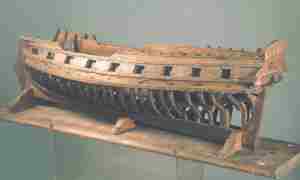
The Model of nave, made by Peter the Great on return from Holland in 1697.On models this shipbuilders
perfect the design of the hull and technological decisions on stocks assembly of new nave. On designs to this mode close
such nave as "Apostle Peter", "Apostle Pavel" and others, built in 1697-1702 in Voronezsh
Support of naval dynasties and preparing the future captains and sea engineers impossible without popularization of sea
sciences, without active development of children's clubs and ship-modeling studios, in which the most complex scientific
problems apply to fascinating research creative activity.
The first Russian sea officers, as own engineers, architects, hydrographer and land-surveyor gave the Russia founded
by Peter the Great in January 14,1701, School "Mathematical and navigational that is to say nautical arts of teaching".
Its first graduates have glorified Russia their own achievements in sciences and military deals. Peter the Great personally
designed the new naves and even made their scale models, reproducing design in accuracy and, accordingly, technology
of their building. Studied ship deal in Holland and England, Peter the Great entered the rule to invite leading foreign
specialists for working in Russia and train the young engineers in Europe, hereunder had linked Russian industry and shipbuilding
with the most latest European technological achievements.
The traditions of Peter's epoch are saved in modern Russia. Youth gets acquainted with bases of sea deal and theory of
nave in clubs of young sailors and ship-modeling studios under the direction of authoritative naval mentors and enthusiasts
of ship sciences. It is important to note that making of exact copies of nave models and use them in sporting competitions
of ship-modelers hardly refers to idle hobby or amusement industry. Undertaking the designed studies in the field
of theory and nave seaworthiness [1], drawing work and fully fledged design and technological working outs on making
of the hull, superstructures, able belongings and ship mechanisms, and often automated systems of management by engines
or sails on acting models-all these skills are just the minimum that young sportsmen ship-modelers should have. Certainly,
in order to receive such knowledge and skills, future navigators have to study the mathematical, navigational and ship sciences
bases, finding them in sea popular, historical and scientific and technical literature, at the same time getting know history
of naval art, mode and relations between sailors and ship commanders, laying hereunder strong bases for mastering
the sea profession. The laborious craft and pangs of creative work are usually recompenses by meeting with experienced navigators
at sporting competitions and exhibitions of models of ships, where young sailors' understanding of deep essence of real
sea deal becomes stronger, and at the same time the special sea language and deck slang. Certainly, in the future,
not all pupils of youthful sea clubs will throw in their lot firmly with sea deal, but to become creative thinking engineers
is predestined.
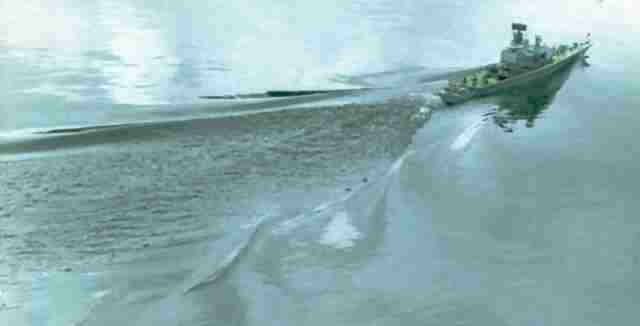
The model of the nave with firm on course and well streamlined hull, rigged by gyrocompass and auto-rudder. The photo is
made on the first place of Russia on ship-modeling sport in classes of self-propelled models and yachts in Omsk in 1971.
The author of project of nave and its models Vladimir Lagutin, Sizran.
The youth sea practice as successful participation in competitions of shipmodelers, especially with author's projects
of models of ships, in many respects is indicative of taken place professional orientation and real qualities of future
sea engineers. However, it is not enough the enthusiasm of instructors and their wards for the first engineering and
scientific achievements. The sea technical creative work must rest upon existing sea infrastructure and original large-profile
ship-modeling production, at the minimum rigged by machine park for tree- and metalworking, electro- and radio technical
instrument complexes, different instruments and without fall - modern drawing-design equipment and science and technical
sea library. So, in 70-e years of past century two well rigged ship-modeling laboratories existed in large port city Sizran, one existed in ancient building of Palace of pioneers, second - in House of culture Sizran's plant of heavy machine
building. Material and technical conditions required young ship-modelers working were created by large industrial
enterprises of Sizran, and unique small-dimensioned electro-technical conditions were made for building in models of ships
any involved automation by Sizran's military helicopter's school, which sent the lads written off aircraft instruments,
containing engines, gyro- ospreys, electro-controllers reduction gear, timers and etc. The The first All-Union competition
of shipmodelers as special military-technical sports was organized by Osoviahim (the Society of assistance to defense,
aircraft and chemical building) in June-July 1940. The Great Patriotic War delayed association of shipmodelers till 1949,
since this time their All-Union meeting became annual, and in 1963 ship-modeling sport was enclosed in United
sporting classification. At that time the Federation of ship-modeling sport USSR was created, which work was supported
by the Central Committee of Voluntary Society of Assistance of Army, Aviations and Fleet (VSAAAF).
Till the end of 1970-begin of 1980th in soviet ship-modeling sport the presentation of models of naves and crafts on
original projects and drawings of young authors was greeted in very possible way, that changed ship-modeling in real
sea science and technical creative work, and competitions of shipmodelers - in contest of sea literacy and real
experimental tests seaworthiness of new models of naves and crafts. Use on self-propelled models all the manner of
devices for deduction them on direct course also was not prohibited, that encouraged the inventive initiative of schoolboys,
rigged their own small naves rather complex mechanisms for automatic control by rudders, engines and stabilizers of hull-
calming of tossing.
Curiously enough that on drawings of Central sea club VSAAAF beside hypothetical naves such as watch nave "Mars", destroyer
"Saturn", cruiser "Jupiter" and even aircraft carrier (without name), prudently the attitude of width to setting to 2-2,5
was lowered, that corresponds to the ancient sailing vessels and noticeably perfects seaworthiness of models on choppiness.
The last was important, as sporting competitions were not cancelled in the event of reinforcement of winds and choppiness,
and young ship-modelers with their own eyes observed the catastrophes of models, connected with their insufficient seaworthiness.
Quite often on one and the same areas of water were conducted the tests of self-propelled models with mechanical engines
and racing of sailing vessels were held.
The estimation of sporting models according to the old Russian rules was conducted by 40-point's scale, in which 10 points
was added for:1)knowledge of sea deal and literacy of working out of project of nave, 2) quality and scale of
making of model,3) stability on course on running test, conducted under any condition of choppiness and wind, 4) exact observance
to scale velocity of move on these tests. Thus, technical creative work of young technicians was orientated on deep studying
of new perspective naves and crafts projects, which were strictly valued on criteria of sea literacy,
but model itself, its automation and technical rig were subjected to hard nautical tests in complex conditions of sail on
open for winds and waves areas of water.
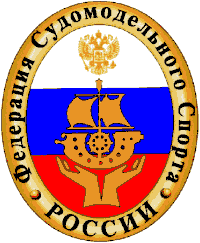 Seal FSSR
Seal FSSR
In 1967 the Federation of ship-modeling sport of Russia has come to a decision about participation in championships
of Europe. The Author's projects no traditional naves were forbidden by the International rules NAVIGA, but in the
rigging of self-propelled models were put bands on use of gyroscopes, stabilizers of tossing and other automatic devices,
perfecting nautical characteristics and stability on course of self-propelled models. Thus, young authors of new naves projects
were offered to make beautiful toys, and sea scientific creative work and understanding of nautical art was
substituted for mastering of modeller-copyist's skill .
According to these rules the sporting models of courts are divided on categories, groups and classes. For example,
in categories E-self-propelled and F-radio-controlled original models of group X-free design also engage in competition,
which are not valued on stand in no way, and therefore the claims on sea literacy of designing the real naves are
not laid to them .This substitutes full-fledged engineering-technical creative work for simple longing to straight-propelled
in E-category or propulsions and maneuverability in F-category , reached by any, including distant from sea practice, technical
methods.
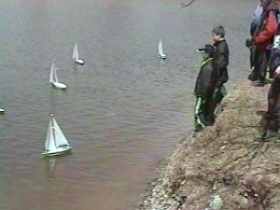
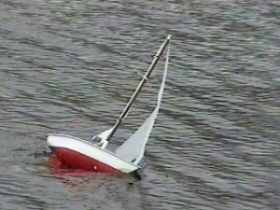
On start outwardly alike yachts (on the left) disperse in the most unexpected courses for young sportsmen. The yacht
of winner (on the right) must not only take wind, but also strictly keep given course or certain maneuver on head
winds.
The Special sea school for ship-modelers the racing sailing yachts present, concerning S-sailing category, as well as
models-copies of radio-controlled sailing naves of F-category. On different classes of racing yachts are put the geometric
restrictions, basically linking sizes of their hull and areas of sails. The technical initiative on perfection of sailing
arms and use the automatic control rudder and sails on models of yachts is not limited especially, that transforms the sporting
appearances of yachtsmen in fascinating competition of original sailing riggings, on-board automation and experience of
yacht management both on weak, and on strong winds, including on serious wind choppiness.
On competitions young shipbuilders fight for youth and then and adult sporting categories. In programs of additional
technical education the making of sought-after model during one academic year is usually envisaged, that allows the
schoolboys in summer to bear several exams on literacy of designing and new naves making , conduct their nautical tests,
as well as control the nautical qualities of other models of courts and make sure of good quality of winners' models.
Losing competitions, young shipbuilder gets the necessary experience in the future, in high-priced real shipbuilding, not
to waste his own power and another's labour on ungrounded invention.
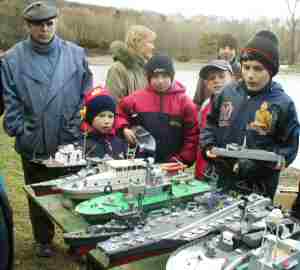
The models of naves and courts of young ship-modelers are prepared to stand estimation on traditional competitions of Sakhalin
schoolboys 9 may 2003.
Yuzhno-Sakhalinsk Palace of children's and youth creative work (PC(y)CW, earlier Palace of pioneers) could save the conditions
for research creative work of schoolboys till present. Ship-modeling laboratory has ample and light premises,
equipped by necessary tree- and metal-working tools, primary there was installed rather big experimental pool. But all existing
ship-modeling studios sharply lacks methodical and technical support. It is rather difficult to conduct the
ship-modeling economy nowadays. The tools and other equipment need constant technical maintenance, the regular
renovation of stock, adjustment and repair radio- and electrical equipment is required, as well as timely renewing of consumables
for making and riggings of models. For presenting the minimum of modern level requirements to undertaking designed works
joining of young ship-modelers to computer preparing of the drawings is necessary, independent making calculations
on nave theory, propulsions and seaworthiness for their new author's models.
It should be noticed that employees of laboratory and institutes of Russian academy of sciences quite often lead sea
search or experimental studies in similar creative situation under the unpretentious technical equipment, which is compensated
by the ability to non-standard thinking and inventiveness of scientists and engineers. In accordance with plan of scientific
works on subject "Seaworthiness" in SRB for automation of Marine Researches of Far Eastern branch of RAS is conducted
estimate and experimental study storm seaworthiness of different classes of naves and crafts [3]. With orientation toward
need of sea research creative work of youth development, in 2003 complex of experimental studies on academic programs
it was managed to comprise young Sakhalin ship-modelers in optional plans. Original scientific and enlighten
mission has enriched the totals of search studies by fresh ideas, new and unexpected experimental discoveries.
Pupils of ship-modeling studio of Yuzhno-Sakhalinsk PC(y)CW have studied storm seaworthiness of historical
naves and courts, accepting active participation in making of models and conductive all experimental tests in conditions
of strong wind and intensive choppiness by itself on Tunaycha lake. In accordance with NAVIGA's rules all drawings were
approved as projects of perspective naves and courts, developed in SRB AMR FEB RAS.
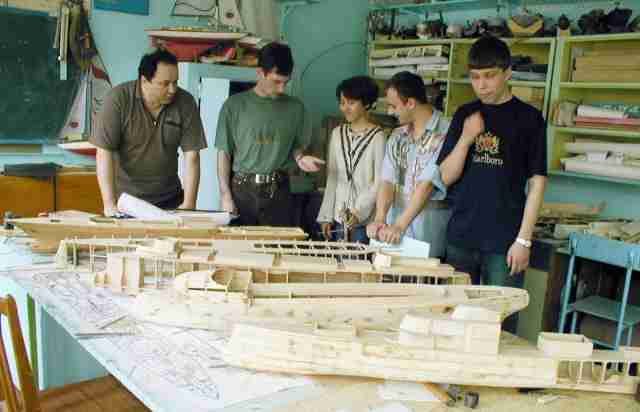
The building of five court models is executed in accordance with technological schemes of S.K.Polischuk (on
the left). Next to him the leader of ñóäîìîäåëüíîé studio V.Y.Kalikin and ship-modelers Laida Kushnaryeva, Alexander Baturin
and Alexander Boyarkin - participants of educational and research works.
The lessons with pupils-ship-modelers has supported oilfield company "Sakhalin Energy", leading active sea works in storm
widths of Sakhalin shelf. The grant of this company has allowed to unite the technical potential of academic science
and all ship-modeling studioes of Yuzhno-Sakhalinsk under the aegis of Sakhalin branch of Russian geographical society.
Traditional competitions of shipmodelers and expeditionary studies of storm seaworthiness radio-controlled models in real
conditions of intensive choppiness and strong wind were conducted jointly.
Hydromechanics, is the science about moving of utter ambiences, full of paradoxes. Intuitive obvious shipbuilding
ideas under active testing in conditions of storm quite often bring to absolutely opposite results or unacceptable consequences.
Pupils could make sure of this during the first experiments on Tunaycha lake (May 2003)

Test output of small model of battleship "Bismark" (M-b 1 : 350) on choppy surface of Tunaycha lake. Demonstrating good
storm seaworthiness ofnave, model has reminded of technical difficulties of maintenance of storm sail safety that, leaving
far off enough from coast, on full move became to sink bow under water.
The models of fishing trawler and traditional warship, conditionally ready to test have taken a part in the first free
sail of self-propelled models on intensive choppiness. While big models were prepared for lowering on water, the small self-propelled
model of battleship "Bismark" was tested on storm area of water, shown good example of storm seaworthiness of prototype
of well- known historical nave. The hull of "Bismark" split large-scale waves easily, advanced confidently and without apparent
loss, keeping upper deck parallel to the surface of wave and having mainly vertical pitching in motion.
The ensemble of questions about methods of provision good seaworthiness on intensive choppiness was appeared in mind
of pupils during preparing the new experimental models. For example, the rules of good sea practice spoke about need to
keep such ways of loading the models by ballast (the ballasting) that parameters of propulsion and pitching was corresponding
to the action of nave-prototype sail in the best way. However by traditions of competitions on calm water, imposed by NAVIGA,
at ship-modeling studio the whole ballast of warship model was placed in bow bulb and near the stern tiller room.
As a result excessive stability and increased inertia of model on pitching rather quickly have brought to the shipwreck:
model sank in free driftage on choppiness, after free-lance engines' stoppage.
The model of fishing trawler completely was ballasted before lowering on Tunaycha lake. The hull of trawler had
dribbles of large warship of the end XIX-begin XX century. Radio-controlled model went toward the steep wave crests
and allowed to make the first surveys for the following analysis of conditions of interactions of hull with large
choppiness and strong wind. The observations for trawler sail have confirmed its best storm seaworthiness.
In June of 2003, for the first time after perennial break, Sakhalin command of shipmodelers took part in guest youth
participations on championship of Khabarovsk region in Komsomol'sk-na-Amure. This was useful as for pupils, as for
their mentors having not high sporting ranks in this military-technical sport. The journey on mainland was on ferry
"Sakhalin", and it was the first going out on large ship for many children. The residents of Komsomol'sk have prepared the
regional championship of young shipmodelers on high level that has confirmed viability of sea technical creative work
on FAR EAST of Russia. There was presented quite a lot of high-quality models of naves, courts and submarines, made
by pupils from Komsomolsk-on-Amure, Khabarovsk, Amursk and other Far-Eastern cities.

There is a model of patrol-hydrographic nave on start. Even in ideal conditions the models of young shipmodelers
are subjected to influence of choppiness and wind, that is why its storm nautical qualities are the keys to success
The residents of Sakhalin, except models of traditional nave (Alexander Boyarkin) and trawler (Andrey Pozdeev) mentioned
above, prepared to competitions model optimized for storm sail is patrol-hydrographic nave - corvette (Semyen Khramushin).
The narrow hull of corvette, designed by analogy with ancient torpedo-boats, demonstrated all difficulties in maintenance
of complex of nautical characteristics this high-speed nave. During ballasting transversal stability of model with heavy
superstructures was got nearly zero that stipulated very easy rolling. Filled up inside hull the surface board of nave,
acting at waterline level, added a good spare of stability to model even under negative initial metacentric height. During
the first going out to sailing the model confirmed the high nautical qualities of their prototypes - ancient torpedo boats.
At the same time the project showed a lot of defects, which gave ground for engineering and theoretical searching
of new decisions on separate elements of form of hulk. So, under influence of strong squalls, swooped on open reservoir,
model heeled and lost stability on course, beginning turning for adduction toward wind. The pupils were offered to find
the reason of problem, inducing them to discuss unwritten rules of good sea practice, bases of nave's hydrodynamic,
optimum form of hull and for the ship as a whole architecture. It turned out that deep-loaded bow bulb
prevented stability on storm course of corvette model , which crooked equivalent line of hull under wind tipping.
At the same time at big speed of move the centre of lateral hydrodynamic resistance was displaced far to the nose,
that, under disposed in the average part of deck superstructure hull, created the conditions for the quick adduction
of model on toward the wind course. To except such characteristics of hulk it is necessary to take away deep-seated bow
bulb, and for stabilization of excessive roving on large choppiness even to cut the lower part of stem, hereunder preventing
possibility of seizure the hull by storm wave on sidelong course corners.
Nevertheless what incurable defects or unacceptable nautical characteristics of models of corvette and trawler
were not noted in the first place confirmed the high quality of designing of lines of speed naves in the end of XIX-beginning
of XX century - the most close prototypes non traditional lines of hull, successfully tested by ship-modelers of Sakhalin.
The most significant action for pupils of Sakhalin became test the models in experimental pool of the department
of shipbuilding of State technical university in Komsomol'sk-na-Amure (the leader of pool c.t.s Nikolai Alexandrovich Mytnik).
During the test of corvette model the important characteristic of ancient sailing naves was revealed, which theoretical
drawing of hull is inserted in geometric circumference [4]. When corvette, possessing very small initial stability, moved
toward large wave, him, in order to avoid the blow against wall of pool, the direction of motion was changed by sharp jerk
of thread-leash there, that is why on steep circulation and under the bows of counter waves the model fell and lay
down on starboard side. However, possessing heavy stock of stability on big corners of list, leaving from beneath the waves,
model once again got up on flat keel and, practically without rocking, continued the quick free motion by sidelong
course toward choppiness. Non-planned hard experiment with this model has shown that ancient naves possessed by high storm
reliability, turnover did not threat them, even when reserves of dynamic stability were supported only toughness of standing
rigging and floatability of sailing masts and spars at masts, prescribed under the wind and waves bows on water surface.

The participants of educational-exploratory work with models of courts increased storm seaworthiness, built in ship-modeling
studio of Yuzhno-Sakhalinsk Palace of children (youth) creative work. Left to right: Pavel Kalikin - traditional
nave; Bogdan Kravchenco - fishing trawler; Alexander Boyarkin - naval salvage - research ship; Michel Afanasief - universal
transport ship; Semyen Khramushin -patrol-hydrographic corvette (5th October, 2003, Tunaycha lake).
During the summer and autumn 2003 all five radio-controlled models, built by pupils of Sakhalin, were removed in
free sail on Tunaycha lake. Operating models, passed different courses and maneuvered on strong wind among enormous, judging
by model measures, storm waves, ship-modelers on own experience could make sure of existing of special art of storm navigation,
in responsibility of sailors for safety of their courts sail , as well as in need of deep designed-technical studying of
lines of hull, its rudders and propelling agents.
During the pupils was occupied with new models of courts, there were prepared two kits of telemetry radio sets
in laboratory of computing hydromechanics and oceanography SRB FEB RAS , allowed to deliver regularly data about velocities
of move and corners of list and trim difference of easily sailing radio-controlled models on coast.
The new experiments were conducted in experimental pool of department of shipbuilding of State technical university in
Komsomol'sk-na-Amure within the bounds of student research works at November - December 2003. The program of tests envisaged
the analysis of propulsion and pinching of models during the moving by different courses concerning crests of regular choppiness.
Video-surveys of immovable and moving close by model documented the way of experiment. The experimental studying of
bases of nave hydromechanics usually reveals the ensemble of technical omissions during designing and building of models
with non-traditional lines of hull. So, the model of trawler loses the move not as much from the bows of counter waves as
from frequent screw propeller baring. The model of corvette stands at slanting courses and log to wave on small moves wonderfully,
but finds well visible list on starboard side during fast motion toward the wave, as it turned out later, it is connected
with asymmetry of propeller shaft installing. Under the bows of waves screw propellers of transport ship started to revolve
alternately, that hampered extremely the deduction of model on course, so far as emergency reverse of rudder from the one
board to another held up its motion.
The curious event has occurred with the model of salvage vessel. The final experiment passed nearly impeccably. Confirming
excellent qualities of Arabic shebeca, the model moved confidently and was controlled on intensive choppiness, showing
the small range of rolling and perfect seaworthiness in every respect. However on the upper deck between bulwarks the high
level of water constantly kept, which was not thrown overboard without scuppers and a little of rolling. And as bulwarks
were above coamings, hidden under the superstructure, that model on the second passage by course on wave unexpectedly sank.
The sea practice does not forgive the disappointing trifles: value-added pouring with a low side hull primary was expected
in the project of this model, but all consequences were not counted.
After multiple experiences, confirmed the rightness of theoretical ideas of designing new courts with non-traditional
form of hull, designed calculations one of the most reliable and simple models prepares to go out to open sea.
Now the model of salvage vessel, inherited the hull from Arabic shebeca and Spanish caravels with temporary of Magellan
and Columbus, was rigged by echo-sounding device, GPS-navigator and radio modem and changed into a small radio controlled
hydrographic vessel. The experiments passed in October-November 2004 on board of hydrographic vessel GS-47 in Okhotsk sea
near Urup and Kunashir islands of Kuril ridge. In autonomous sail at the speed of 1,5-2 knots new remote controlled vessel,
having a good storm seaworthiness, confidently realized sounding and measurement of water surface temperature, incessantly
delivering data about its location and condition of on-board instruments on removed computer by radio channel of measuring
telemetry.

The model of universal transport ship and model of patrol-hydrographicnave on buildingtable. The equipment of radio control
is fixed, and measuring sensors for registration of storm pitching and propulsions of models, having reconstructed historical
lines of hulls are tested
Thus, educational-exploratory works with pupils of Sakhalin were terminated not only motivated conclusions about
a good storm seaworthiness of historical naves, but also important practical result - successful test of super-small
nave-robot, capable of executing the oceanological research with the minimum influence on sea surroundings.
So interesting educational-exploratory and experimental works of Sakhalin pupils were realized on the basis of laboratory
of computing hydromechanics and oceanography of SRB AMR FEB RAS, with Branch of Russian geographical society on Sakhalin
and enjoying the support of "Sakhalin Energy" company, realizing the most complex sea oil and marketable works in
storm widths of north-eastern shelf of Sakhalin island. The main results of joint scientific researches and creative achievements
of Sakhalin ship-modelers are published in scientific-enlighten publishing "History of storm seaworthiness (from antiquity
till present)" [2] and in Internet on the official address of Sakhalin science (www.shipdesign.ru/Geography/2003).
In collaboration the new technical decisions useful for modern practice of sea prospecting were found, as well as
new problems were put, in the first place connected with searching for mathematical and experimental decisions for non-stationary
problems of nave hydromechanics, interactions of ocean and atmosphere.
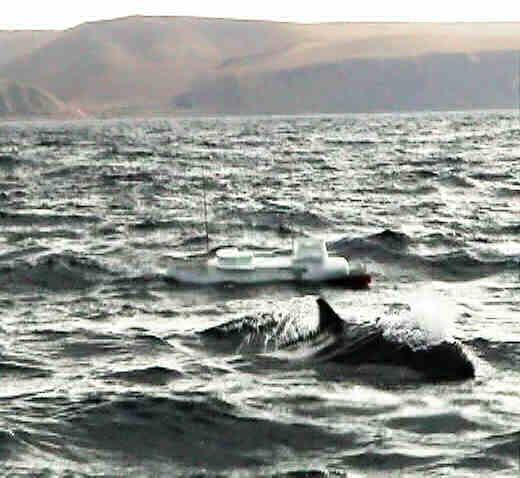
The ship must live in harmonies and unity with sea. If nautilus is very small, but she is capable of undertaking the
real hydrographic works in conditions of heavy waves, as well as there, where it is not safely for real ship or boat with
people on board to appear. For the present the first going out of new vessel to the sea is greeted the white-sided
dolphins. One of the them seems to have taken nautilus for "its" and has played with it during the whole whole experiment
in open sea (October 2004, Urup island of Kuril ridge)
BIBLIOGRAPHY
- Jilmer Tomas. Designing of modern nave. L.: Shipbuilding, 1984. 240 S
- The History of storm seaworthiness (from antiquity till present) / V.N.Khramushin, S.V.Antonenko, A.À.Komaricin
and others. Yuzhno-Sakhalinsk: Sakhalin book. publishing, 2004. 288 S.: illus., multimedia. encl. (CD-ROM).
- Khramushin V.N. The Search studies of nave storm seaworthiness. Vladivostok: Dalnauka, 2003. 172 S.
- Chapman F.H. Architectura Navalis Mercatoria. Rostok:VEB Hinstorf Verl.,1968.104 S.
Khramushin Vasily Nikolaevich - Candidate of technical sciences, (Special Research Bureau for Automations
of Marine Researches FEB RAS, Yuzhno-Sakhalinsk).
BULLETIN OF THE FAR EASTERN BRANCH, RUSSIAN ACADEMY OF SCIENCES, ¹ 1, 2006
V.N. Khramushin. Marine science and research activity of youth. ð.137-148

 Vasily N. Khramushin
Vasily N. Khramushin
 Seal FSSR
Seal FSSR







